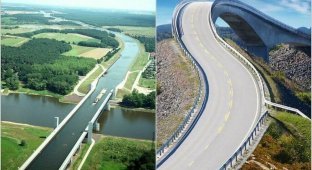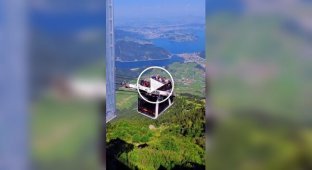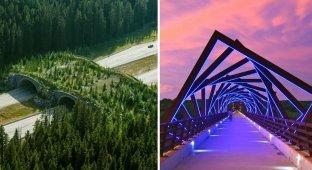Bridges beyond reality: ten of the most unusual crossings on our planet (11 photos)
From ancient wooden structures to futuristic spirals, from biblical wonders to engineering audacity, bridges are not just crossings, but real works of art. 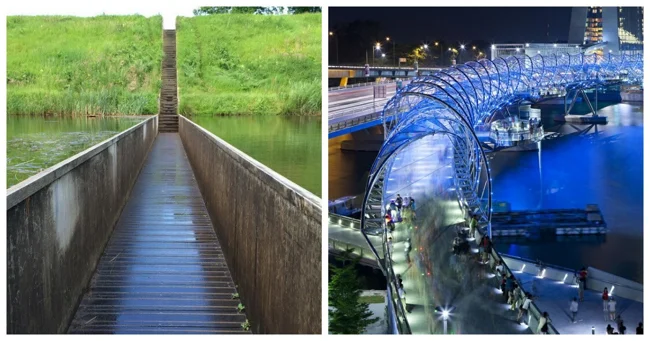
In this collection, we have collected the most amazing bridges in the world that defy the laws of physics, play with our perception and open up views that are worth overcoming the fear of heights. Ready to walk on the edge?
1. Chapel Bridge, Lucerne, Switzerland 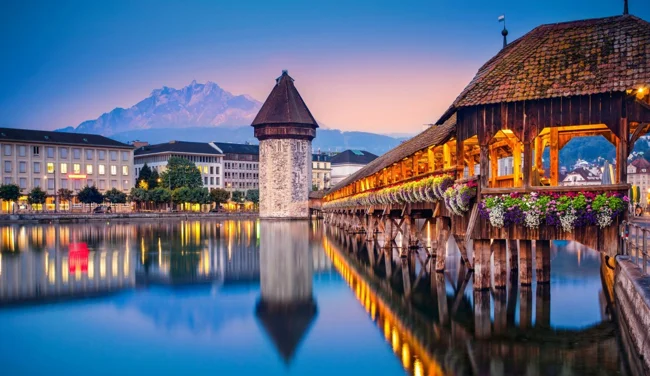
In the heart of Lucerne, Switzerland, over the calm waters of the Reuss River, rises the Chapel Bridge, the oldest wooden covered bridge in Europe, whose history began in 1365. Built as part of the city fortifications, it served not only as a crossing, but also as a defensive line, protecting Lucerne from invasions.
The bridge is 204.7 meters long, and its distinctive feature is its unique triangular roof, under which 111 ancient paintings from the 17th century are hidden. These Renaissance-style images tell of key events in Swiss history and the lives of the city's patron saints.
Next to the bridge stands the octagonal Wasserturm (1300), which is half a century older than the Chapel Bridge itself. During its long life, it has served as a watchtower, a prison (including for witches), a torture chamber, an archive, and even a fire tower. Today, it houses a souvenir shop and part of the historical exhibition.
2. Yongji Bridge (Dong Bridge), China 
In the picturesque Guangxi Zhuang region, near the city of Liuzhou, the Yongji Bridge spans the water - an amazing structure where Chinese traditions are intertwined with engineering ingenuity. Built between 1912 and 1924, it became the embodiment of the craftsmanship of the Dong people, famous for their unique wooden buildings without a single nail.
The bridge is 76.6 meters long, only 3.75 meters wide, and its height above the water reaches 20 meters. The foundation is formed by massive stone supports that withstand the river flow and seasonal floods. The main decoration is a two-tiered roof with curved slopes, carved cornices and five-tiered pagodas reminiscent of temple towers.
This is not just a bridge, but a multifunctional space. Under its roof, travelers take shelter from the rain, locals relax, and tourists admire the scenery.
3. Khaju Bridge, Isfahan, Iran 
In the heart of Isfahan, on the site of an ancient crossing, Shah Abbas II built the Khaju Bridge in 1650. This is not just a river crossing, but a multifunctional engineering marvel.
It is 133 meters long and 12 meters wide, which is enough for caravans and processions. 23 arches made of stone and brick are decorated with turquoise tiles in traditional Persian style. The bridge works as a dam, regulating the flow of water for irrigation of the famous Isfahan gardens.
4. Millau Viaduct, France 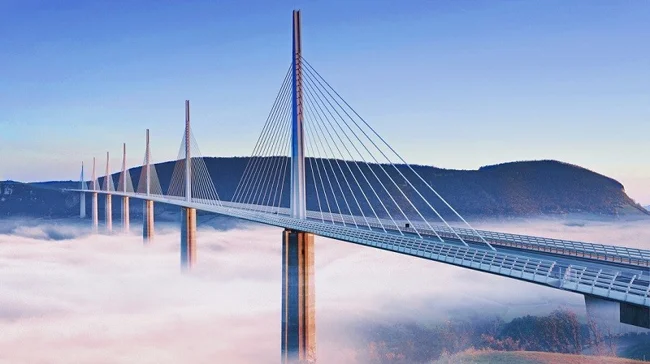
In the south of France, where the Tarn River valley cuts through the mountains, the Millau Viaduct soars 343 meters high. Opened in 2004, this cable-stayed giant of steel and concrete is a triumph of engineering.
It is 2,460 meters long (the length of 60 football fields). Seven graceful pylons support 36,000 tons of roadway. The road is intentionally curved (3% slope) for safety and panoramic views
The bridge was built in just 3 years, which is record-breaking for such a large-scale project. The pylons adjust to the expansion of the metal in the heat. In bad weather, the upper supports disappear into the clouds. It remains the highest road bridge in the world according to the Guinness Book of Records.
5. "Moses Bridge", Halsteren, Netherlands 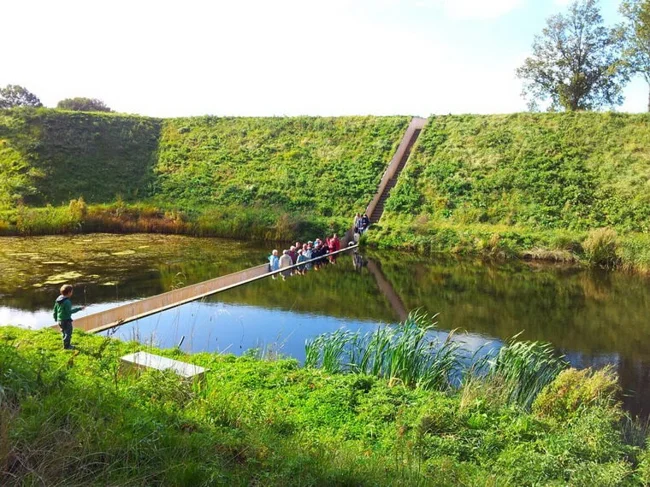
In the Dutch Fort de Roover (17th century), in 2011, a bridge appeared that literally cuts through the water, as in the legend of the prophet Moses.
The pedestrian bridge is submerged in a meter-deep ditch, creating the illusion of parted water. Pumps and dams protect against flooding. The construction used treated waterproof wood (acacia) and modern coatings.
The bridge is 50 meters long (20 meters under water). The cost was €250,000. The bridge disappears into the landscape, preserving the historical appearance of the fort.
6. Capilano Bridge, North Vancouver, Canada 
For over 130 years, the famous suspension bridge has been hovering over the turbulent waters of the Capilano River in Canada – a living testament to engineering ingenuity. Built in 1889 by a Scottish engineer as a utilitarian crossing for sawmill workers, it was a precarious sight back then: narrow planks supported by precarious hemp ropes.
A modern renovation has transformed Capilano into a safe but no less exciting attraction. At 70 meters high and stretching 137 meters between rocky banks, the bridge demonstrates amazing strength. In theory, it can withstand the weight of almost a hundred elephants. However, even steel cables do not save it from the swaying characteristic of suspended structures, especially noticeable in windy weather or when there are large crowds of visitors.
But the true value of Capilano is in its unrivaled views. Regardless of the season, the bridge offers stunning panoramas. Dense pine forests, a deep canyon and a river bubbling below create a sense of unity with wild nature.
7. Banpo Bridge, Seoul, South Korea 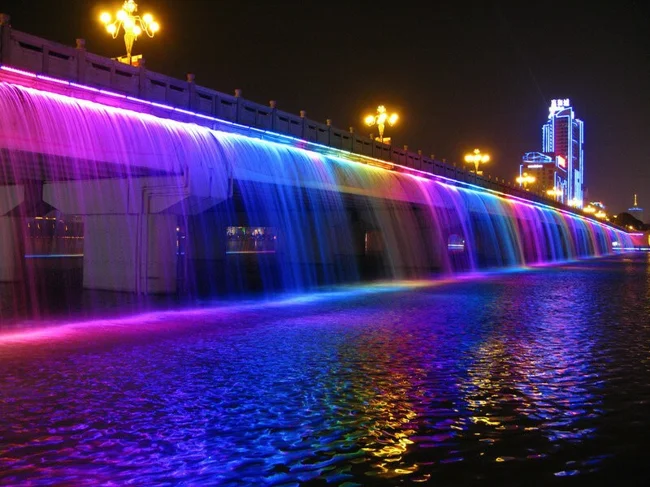
In the heart of Seoul lies an amazing engineering marvel – Banpo Bridge, known throughout the world as the “Rainbow Fountain”. This unique object, listed in the Guinness Book of Records, is not just a river crossing, but a grandiose water show 1,140 meters long.
Opened in 2009, the bridge amazes with its unconventional concept. Instead of traditional fountains shooting upwards, thousands of jets of water shoot sideways and downwards, creating the effect of a floating curtain of water. Each jet, up to 20 meters long, dances to music, illuminated by ten thousand multi-colored LEDs.
This spectacle is especially impressive in the evening hours, when the bridge turns into a shining artery of the city. From April to October, the fountain uses a whopping 190 tons of water every minute, putting on an unforgettable show for residents and visitors of Seoul.
8. Helix Bridge, Singapore 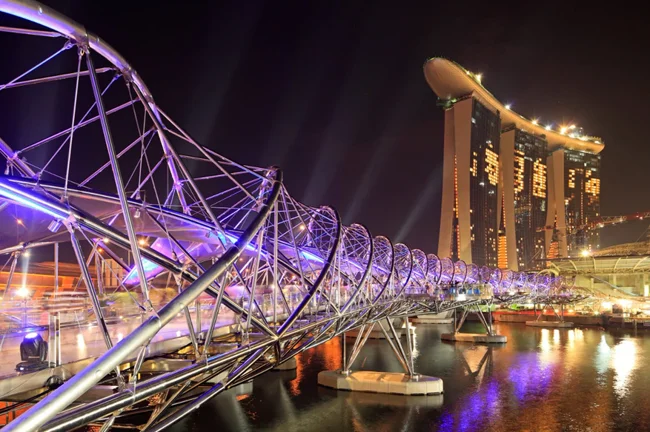
In the futuristic Marina Bay district, the Helix pedestrian bridge, one of the most unusual structures in the city-state, twists like a graceful steel ribbon. Opened in 2010, this 280-meter masterpiece in the form of a double helix, created jointly by Australian and Singaporean architects, embodies the very essence of life – the structure of human DNA.
Every detail of the bridge has been carefully thought out: the multi-colored letters C, A, T and G, illuminated in the dark, symbolize the nitrogenous bases (cytosine, adenine, thymine and guanine), creating the feeling that you are walking on a giant molecule of life. Four observation decks built into the spiral offer panoramic views of the glittering skyscrapers of Singapore, especially impressive at night, when the steel structures come alive in a dance of light effects.
10. Langkawi Sky Bridge, Kedah, Malaysia 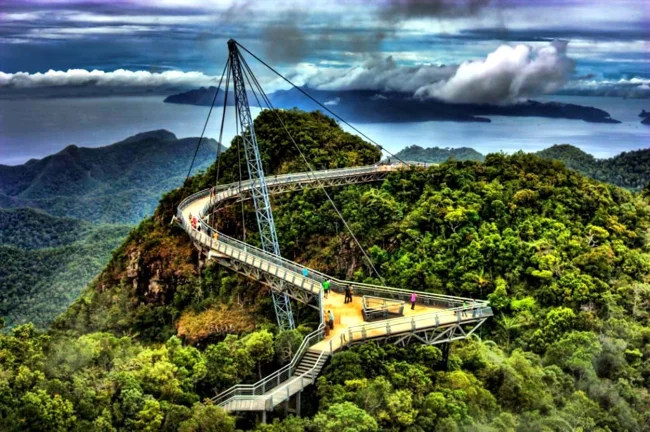
At an altitude of 660 meters above sea level, among the peaks of the main island of the Malaysian archipelago Langkawi, one of the most impressive pedestrian bridges in the world hovers. This structure, literally hovering over tropical forests and the Andaman Sea, fully justifies its poetic name - the Sky Bridge.
The construction of this engineering miracle required non-standard solutions: all the elements of the structure were delivered to the top of Mount Mat Chinchang using helicopters, where they were then assembled into a single whole with jewelry precision. The result exceeded all expectations. The curved 125-metre suspension bridge, supported by just one support, creates a feeling of weightlessness.
The main treasure of the Sky Bridge is its breathtaking views. Its transparent deck offers panoramic views of untouched jungle, turquoise waters of the strait and distant islands of the archipelago.












